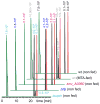A RubisCO-like protein links SAM metabolism with isoprenoid biosynthesis
- PMID: 23042035
- PMCID: PMC3475740
- DOI: 10.1038/nchembio.1087
A RubisCO-like protein links SAM metabolism with isoprenoid biosynthesis
Abstract
Functional assignment of uncharacterized proteins is a challenge in the era of large-scale genome sequencing. Here, we combine in extracto NMR, proteomics and transcriptomics with a newly developed (knock-out) metabolomics platform to determine a potential physiological role for a ribulose-1,5-bisphosphate carboxylase/oxygenase (RubisCO)-like protein from Rhodospirillum rubrum. Our studies unraveled an unexpected link in bacterial central carbon metabolism between S-adenosylmethionine-dependent polyamine metabolism and isoprenoid biosynthesis and also provide an alternative approach to assign enzyme function at the organismic level.
Conflict of interest statement
The authors declare no competing financial interests.
Figures






References
-
- Hanson TE, Tabita FR. A ribulose-1,5-bisphosphate carboxylase/oxygenase (RubisCO)-like protein from Chlorobium tepidum that is involved with sulfur metabolism and the response to oxidative stress. Proceedings of the National Academy of Sciences of the United States of America. 2001;98:4397–4402. - PMC - PubMed
Publication types
MeSH terms
Substances
Grants and funding
LinkOut - more resources
Full Text Sources
Other Literature Sources
Molecular Biology Databases

